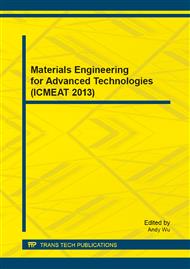p.45
p.51
p.57
p.63
p.73
p.79
p.86
p.91
p.97
Effects of the Filler Properties on Removal Nitrogen of Wastewater in Hybrid Biofilm-Activated Sludge Process
Abstract:
To develop the proper filler for improving removal efficiency of ammonia nitrogen in the activated sludge process of wastewater treatment, the effects of the filler properties and treatment conditions on removal efficiency of ammonia nitrogen in hybrid biofilm-activated sludge process were investigated by the lab-scale test and pilot-scale test. Moreover, the feasibility of simultaneous nitrification and denitrification (SND) was explored with biofilm treatment for chemical poor-biological wastewater. The results showed that SND occurred in the aerobic section. The effluent total basicity (TB) in biofilm process was more than 2mmol / L, higher than activated sludge process. Correspondingly, the effluent TB in activated sludge process was about 0.1mmol / L, and nitrate produced by activated sludge process was 30 mg/L higher than biofilm process. Under the condition of HRT of 24 h for hydrolysis-acidification tank, HRT of 4 h for anoxic tank and HRT of 16 h for aerobic tank, effluent NOˉx-N with combination type of filler in biofilm process was 20mg/L less than that with the activated sludge process. TB with combination type of filler in biofilm process was 2mmol/L less than that with the activated sludge process. Nitrogen removal efficiency was 10.46% with SJ-1 type of filler (made in Jiangsu Suzhou Purification Group Co.,Ltd) more than with combination type of filler. The effluent NOˉx-N concentrations was less than.15mg/L in biofilm process with SJ-1 type of filler. A practical mathematical model with the A/O process was developed for predicting removal effects, which can provide a theoretical guidance for wastewater treatment and engineering design.
Info:
Periodical:
Pages:
73-78
Citation:
Online since:
February 2014
Authors:
Keywords:
Price:
Сopyright:
© 2014 Trans Tech Publications Ltd. All Rights Reserved
Share:
Citation:


